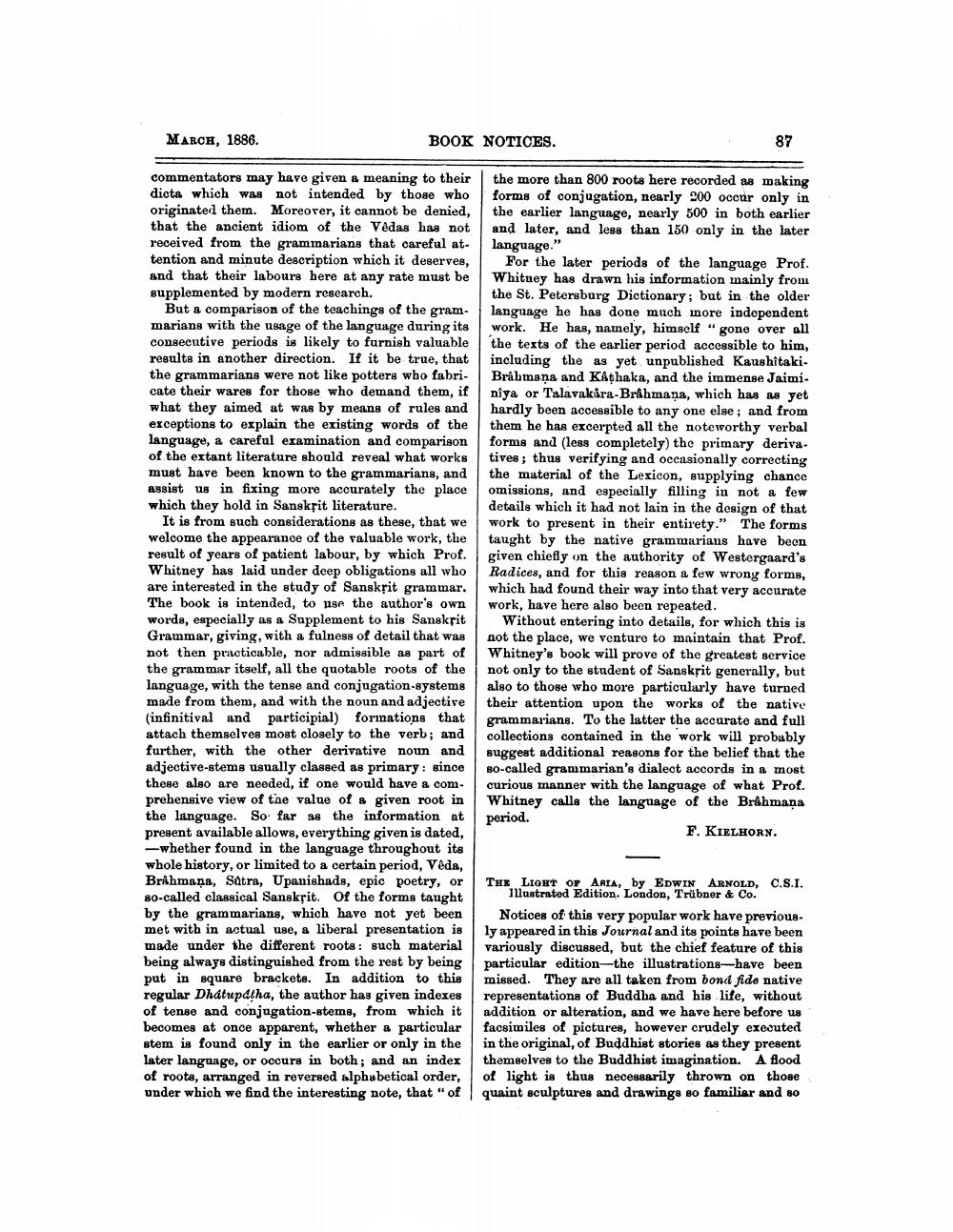________________
MARCH, 1886.
BOOK NOTICES.
87
commentators may have given a meaning to their dicts which was not intended by those who originated them. Moreorer, it cannot be denied, that the ancient idiom of the Vedas has not received from the grammarians that careful at. tention and minute description which it deserves, and that their labours here at any rate must be supplemented by modern research.
But a comparison of the teachings of the gram- marians with the usage of the language during its consecutive periods is likely to furnish valuable results in another direction. If it be true, that the grammarians were not like potters who fabri. cate their wares for those who demand them, if what they aimed at was by means of rules and exceptions to explain the existing words of the language, a careful examination and comparison of the extant literature should reveal what works must have been known to the grammarians, and assist us in fixing more accurately the place which they hold in Sanskpit literature.
It is from such considerations as these, that we welcome the appearance of the valuable work, the result of years of patient labour, by which Prof. Whitney has laid under deep obligations all who are interested in the study of Sanskrit grammar. The book is intended, to use the author's own words, especially as a Supplement to his Sanskrit Grammar, giving, with a fulness of detail that was not then practicable, nor admissible as part of the grammar itself, all the quotable roots of the language, with the tense and conjugation systems made from them, and with the noun and adjective (infinitival and participial) formations that attach themselves most closely to the verb; and further, with the other derivative noun and adjective-stems usually classed as primary: since these also are needed, if one would have a com. prehensive view of the value of a given root in the language. So far 98 the information at present available allows, everything given is dated, --whether found in the language throughout its whole history, or limited to a certain period, Véda, Brahmana, Satra, Upanishads, epic poetry, or 80-called classical Sansksit. Of the forms taught by the grammarians, which have not yet been met with in actual use, a liberal presentation is made under the different roots : such material being always distinguished from the rest by being put in square brackets. In addition to this regular Dhdtupdtha, the author has given indexes of tense and conjugation-stems, from which it becomes at once apparent, whether a particular stem is found only in the earlier or only in the later language, or occurs in both; and an index of roots, arranged in reversed alphabetical order, under which we find the interesting note, that " of
the more than 800 roots here recorded as making forms of conjugation, nearly 200 occur only in the earlier language, nearly 500 in both earlier and later, and less than 150 only in the later language."
For the later periods of the language Prof. Whitney has drawn his information mainly from the St. Petersburg Dictionary, but in the older language he has done much more independent work. He has, namely, himself "gone over all the texts of the earlier period accessible to him, including the as vet unpublished Kaushitaki Brábmana and Kathaka, and the immense Jaimi. niya or Talavakara-Brahmana, which has as v hardly been accessible to any one else; and from them he has excerpted all the noteworthy verbal forms and (less completely) the primary deriva. tives; thus verifying and occasionally correcting the material of the Lexicon, supplying chance omissions, and especially filling in not a few details which it had not lain in the design of that work to present in their entirety." The forms taught by the native grammarians have been given chiefly on the authority of Westergaard's Radices, and for this reason a few wrong forms, which had found their way into that very accurate work, have here also been repeated.
Without entering into details, for which this is not the place, we venture to maintain that Prof. Whitney's book will prove of the greatest service not only to the student of Sanskrit generally, but also to those who more particularly have turned their attention upon the works of the native grammarians. To the latter the accurate and full collections contained in the work will probably suggest additional reasons for the belief that the 80-called grammarian's dialect accords in a most curious manner with the language of what Prot. Whitney calls the language of the Brahmana period.
F. KIELHORN.
The LIGHT OF ARIA, by EDWIN, ARNOLD, C.S.I.
Illustrated Edition. London, Trübner & Co. Notices of this very popular work have previous ly appeared in this Journal and its points have been variously discussed, but the chief feature of this particular edition--the illustrations--have been missed. They are all taken from bond fide native representations of Buddha and his life, without addition or alteration, and we have here before us facsimiles of pictures, however crudely executed in the original, of Buddhist stories as they present themselves to the Buddhist imagination. A flood of light is thus necessarily thrown on those quaint sculptures and drawings so familiar and so




